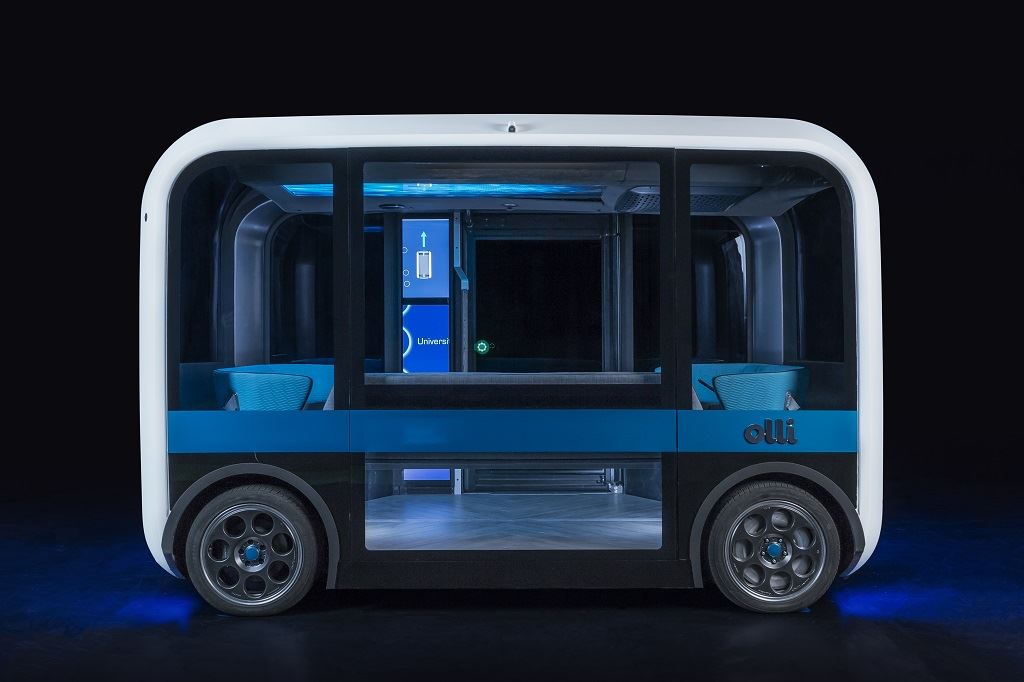![Olli 2.0 [Image: Local Motors via TechCrunch]](https://fabbaloo.com/wp-content/uploads/2020/05/Olli_2.0_Left_Door1_img_5eb090f162ff5.jpg) Olli 2.0 [Image: Local Motors via TechCrunch]
Olli 2.0 [Image: Local Motors via TechCrunch]
Local Motors’ autonomous Olli vehicle is now in its second generation, with more 3D printing and potential to become wider spread.
The vehicle debuted about three years ago, offering an intriguing futuristic vision of personalized-yet-public transport. That futuristic vision entailed 3D printing, as so many “futuristic” designs do — and at the time, we weren’t necessarily sure why that was.
Olli 1.0 has been expanding, with interest catching on and pilot installations in several cities around the US. The first time I saw Olli was at IMTS 2016, when large lines formed to board the vehicle in a basement-ish area of the show; I didn’t take a ride at the time (and haven’t since), but the queues were certainly testament to interest and popularity at one of the largest events in manufacturing.
Olli 2.0
This summer, we meet Olli 2.0. The next generation version features several notable upgrades and design changes, while also recognizable as the friendly-looking little vehicle we met some years ago.
In TechCrunch, author Kirsten Korosec presents a good look at the next-gen “friendly robot” of a ride. She notes that the new vehicle maintains the 25mph top speed, crash testing, and “Level 4 autonomous capability, a designation by the SAE that means the vehicle can handle all aspects of driving in certain conditions without human intervention” as its predecessor.
Adding to those retained attributes are a few new features. Olli 2.0:
-
Is 80% 3D printed
-
Has hub motors (rather than the axle wheel motors of 1.0)
-
Has up to a 100-mile range per single charge (up notably from a 40-mile nominal range in 1.0)
-
Has two additional seats (as the standard)
-
Features new programmable lighting
Additionally, and notably, Olli 2.0 is said to be more customizable.
This customization might be the key to our lingering questions about why it would be 3D printed in the first place; as our own Kerry noted three years ago, conventional manufacturing technologies still make more sense for most parts of mass-manufactured vehicles that won’t see a lot of change between individual units.
On the outside, Olli 2.0 is kitted out with a PA system and front- and rear-facing screens for pedestrian access — and cheeriness.
“The screen in the front can be shown as eyes, making Olli 2.0 more approachable and anthropomorphic,” Korosec writes.
Adorable.
![Really, precious. [Image: Local Motors via TechCrunch]](https://fabbaloo.com/wp-content/uploads/2020/05/Ollieyes1-11_img_5eb090f1c89fd.jpg) Really, precious. [Image: Local Motors via TechCrunch]
Really, precious. [Image: Local Motors via TechCrunch]
The inside sees upgrades in UI with improved touchscreens, speakers, and microphones. Optional additions include AR and VR, as well as interior setups customized for usage — e.g., more seating for university campus transport, more open space for hospital bed loading.
Some of the most intriguing updates announced in Korosec’s piece relate to the included AI. From IBM Watson in 1.0, the newer version integrates either or both Watson and/or Lex from Amazon. Users can vocally command the vehicle by calling it by name.
Making Olli
Digital manufacturing is obviously in focus for Olli 2.0.
Not many details are easily findable — a look through Local Motors’ site indeed yields surprisingly little information specific to Olli 2.0 — but Korosec’s piece does include some hints.
Local Motors is fond of the microfactory structure of production, where the company uses 3D printing processes that evolved at Oak Ridge National Laboratory (ORNL). These two microfactories are indicative of low-volume manufacturing, which fits in well for 3D printing.
Again lacking in detail is exactly what’s 3D printed and what’s not. The percentage of parts is quite high for a vehicle, and it’s also not clear whether that 80% is of total part count or otherwise calculated. Presumably most of the 3D printed parts are interior and made of polymers — but again, that’s a presumption at present. Local Motors did roll onto the scene initially with a fully 3D printed vehicle, so it’s certainly not out of the question that interior and/or structural parts might have been 3D printed; Olli just has rather a different look than the Strati.
The specs listed on Local Motors’ “Meet Olli” page seem still to refer to the 1.0 model, but surely we’ll see more publicly available information soon.
Olli 2.0 is in production now, having started in July; Q4 is slated for first deliveries. Olli 1.0 is currently still shipping out, but it sounds like only for current customer orders including three new deployments. A European microfactory is in the works too, as the shuttle heads overseas.
Via TechCrunch

